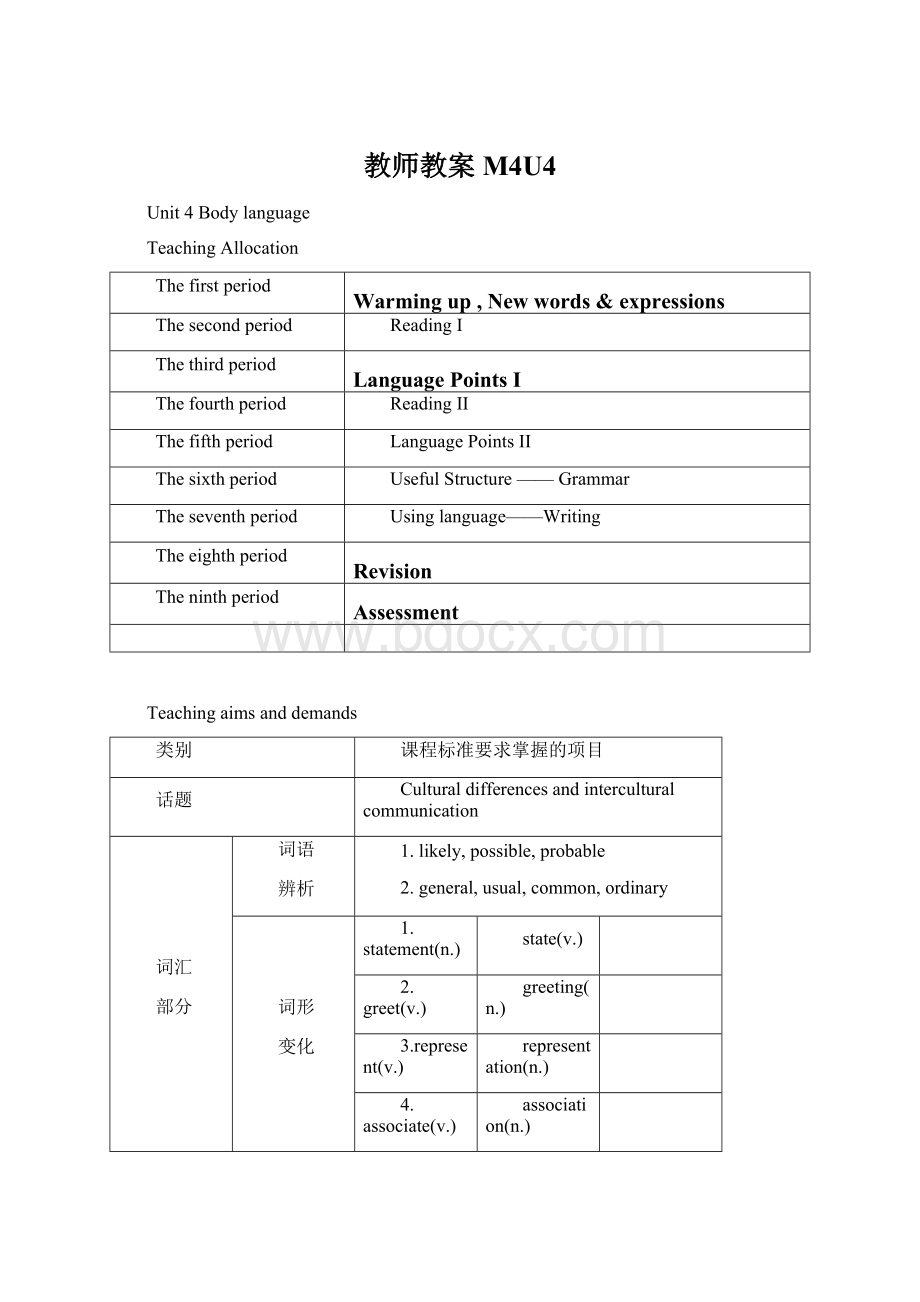 教师教案M4U4Word文档下载推荐.docx
教师教案M4U4Word文档下载推荐.docx
- 文档编号:19248244
- 上传时间:2023-01-04
- 格式:DOCX
- 页数:17
- 大小:27.54KB
教师教案M4U4Word文档下载推荐.docx
《教师教案M4U4Word文档下载推荐.docx》由会员分享,可在线阅读,更多相关《教师教案M4U4Word文档下载推荐.docx(17页珍藏版)》请在冰豆网上搜索。

类别
课程标准要求掌握的项目
话题
Culturaldifferencesandinterculturalcommunication
词汇
部分
词语
辨析
1.likely,possible,probable
2.general,usual,common,ordinary
词形
变化
1.statement(n.)
state(v.)
2.greet(v.)
greeting(n.)
3.represent(v.)
representation(n.)
4.associate(v.)
association(n.)
5.curious(adj.)
curiosity(n.)
curiously(adv.)
6.defend(v.)
defence(n.)
7.majority(n.)
major(adj.)
8.misunderstand(v.)
misunderstanding(n.)
9.speak(v.)
spoken(adj.)
反义词unspoken(adj.)
10.Spanish(adj.)
Spain(n.)
11.face(n.)
facial(adj.)
12.function(v.&
n.)
functional(adj.)
13.true(adj.)
truly(adv.)
14.angry(adj.)
anger(n.)
重点
单词
statementgreetrepresentassociationdormitorycanteenflightcuriouscuriouslyapproachcheekmajormisunderstanddashadultspokenSpainItalycrossroadsfacialfunctiontrulyfalseangerfistyawnsubjectivehugrankcassette
词组
defendagainstbelikelytoingeneralateaselosefaceturnone’sbackto
重点句子
1.Afterhalfanhourwaitingfortheirflighttoarrive,Isawseveralyoungpeopleenterthewaitingarealookingaroundcuriously.
2.ThefirstpersontoarrivewasTonyGarciafromColumbia,closelyfollowedbyJuliaSmithfromBritain.
功能
1.禁止和警告(Prohibitionandwarning)
2.义务和责任(Obligation)
语法
动词的-ing形式作定语和壮语(The–ingformastheattributeandadverbial)
1.作定语
2.作状语
TheFirstPeriod第一课时
NewWords,Expressions&
Warmingup
ITeachingaims
Abilityaims
1)Correctspellingofthewordstobelearnt.
2)Knowthemeaningsandpartsofspeechofthewordstobelearnt.
Languageaims
1)Thestudentsarerequiredtoknowhowtousethewordstobelearnt.
2)Thestudentsarerequiredtobeabletounderstandandreadthingstalkedorwrittenwiththewordstobelearnedinthisperiod.
IITeachingimportantpoints
Wearemainlytoteachthekeywordsandexpressionspickedoutinthisunit.Getthestudentstobeabletounderstandthemeaningandgrasptheusageofthewordschosen.
IIITeachingprocedures
Step1DerivationPractice
IFindoutderivationinP96-97andwritethemdown.从98-99页单词表中找出派生词并写下。
II.FinishP28EXX.1&
2andP63Ex.1.
Step2Warmingup
1.Question:
Howdopeoplecommunicatewithothers?
ShowsomepicturestohelpSstounderstandthedifferentwaysofcommunication:
spokenlanguage,writtenlanguageandbodylanguage.
2.ShowsomepicturesandgetSstoguessWhatthepeopleinthepicturearetryingtotellusand
howtheyareexpressingthemselves.
3.Question:
Whatisbodylanguage?
HelpSstoknowaboutbodylanguage.
4.Listentoasongandfillintheblanks.
5.SummaryBodylanguaeplaysandimportantroleindailycommunication.
Step3Homework
1.FinishP28EX3andP63Ex.2.
2.TopEnglishP66Pre-classpreparation.
TheSecondPeriod第二课时
ReadingI
*Knowledgeaims:
1.Tolearnsomewordsandexpressions.
2.Tomakesurethestudentshaveafullunderstandingofthetext.
3.TohelpSsknowaboutculturaldifferencesandinterculturalcommunication
*Abilityaims:
1.Tocultivatethestudents’readingability.
2.Tocultivatethestudents’oralEnglishskillsandrelatedknowledgeaboutacountry.
*Moralaims:
1.TohelpSsknowaboutculturaldifferencesandinterculturalcommunication
2.Toeducatethestudentstoworktogethertofinishsometasks.
3.Toarousethestudents’interestinlearningEnglishthroughvariousactivitiesinclass.
Teachingimportantpoints:
1.Tomakethestudentshaveafullunderstandingofthetext.
2.TohelpSsknowaboutculturaldifferencesandinterculturalcommunication
Teachingdifficultpoints:
1.Toimprovethestudents’readingability.
2.Toenablethestudentstovoicetheiropinionsfreely.
Teachingprocedures
Step1Assessment考查学生词汇。
Step2Checkinghomework
Step3Leadin
GetSstoguessthemeaningsofsomegestures.
Thenask:
Dopeopleallovertheworldactthesame?
HelpSsreadyforthereading.
Step4While-reading
Task1Fastreading:
Matchthemainideaofeachpartwithlines.
Part1(Para1)Differentpeoplehavedifferentbodylanguage.
Part2(Para2&
3)Summaryofbodylanguage.
Part3(Para4)Iwassenttotomeetthisyear’sinternationalstudents.
Part4(Para5)Examplesofcultural“bodylanguage”.
Task2Carefulreading:
ReadeachpartandanswerquestionsortellTorF.
Part1(Para1)
1.WhyarethepeoplevisitingChina?
TheyarecomingtostudyatBeijingUniversity.
2.Wherewouldtheauthortakethevisitors?
Theauthorwouldtakethemfirsttotheirdormitoriesandthentothestudentcanteen.
3)
1.Mr.GarciafromColumbiaarrivesaheadofMs.SmithfromBritain.(T)
2.ThevisitorfromJapanandGeorgeCookfromCanadashakehandswitheachotherwhentheyareintroduced.(F)
3.WhydoestheauthormovebackfromAhmedAziz?
BecauseAhmedAzizisstandingveryclosetotheauthor.
4.WhatdoFrenchpeopleoftendowhentheymeetpeopletheyknow?
Theyshakehandsandkisseachothertwiceoneachcheek.
Part3(Para4&
5)
1.Somebodylanguagesinsomecountriesaregoodwhilesomecountries’arebad.(F)
2.Canweexpectpeopleeverywheretoactthesame?
Why?
No,wecan’t.Becausenotallmembersofallculturesbehavethesameway.
Task3Intensivereading:
Readthepassageagainandfinishthechart.
Examples
▪Mr.GarciafromColumbia____________JuliaSmithfromBritain,toucheshershoulderandkissesheronthecheek;
▪Ms.Smithsteppedbackappearingsurprisedandputupherhands,asif_____________
▪Mr.CookfromCanada_________hishandouttotheJapanesewho________,andtheJapanese’snosetouchesMr.Cook’smovinghand.
AhamedAzizfromJordanmovesvery_________measIintroducemyselftohim.Butheonly______atMs.SmithandMadameCoulon;
Imovebackabit.
MadameCoulonfromFranceshakeshandswithMr.Garciaandtheykisseachother___________oneachcheek.
▪Englishpeopleusuallydon’tstandveryclosetoothersor_______strangersassoonastheymeet;
▪PeoplefromSpain,Italyor______________countriesapproachotherscloselyandaremorelikelytotouchthem;
▪_________peopleusuallyshakehandswiththepeopletheyknowandkisseachothertwiceoneachcheek;
▪MenfromtheMiddleEastorsomeMuslimcountriesoftenstandquiteclosetoothermentotalk,butmanyofthemwillnotshakehandswith___________.
Keys:
approachesindefencereachesbowsclosetonodstwicetouch
SouthAmericanFrenchwomen
Step5Post-reading
I.DoEXVIIonP73.(TopEnglish)
II.Analysizedifficultsentences.
Step6Homwwork
1.TopEnglish预习第66-70页的Keysentences和Vocabularystudy.
2.完成PreiewOutline第三课时LanguagePointsI全部练习。
TheThirdPeriod第三课时
1.Abilityaims
Thestudentsarerequiredtoknowhowtousetheusefulstructures,wordsandexpressionstobelearnt.
2.Languageaims
Thestudentscandiscoverandmastertheusefulstructures,wordsandexpressions..
Thestudentscanlearnhowtousetheusefulstructures,wordsandexpressions.
IIITeachingdifficultpoints
Thestudentscanlearnhowtodiscover,masterandusetheusefulstructures.
IVTeachingmethods
Asking-and-answeringactivitytocheckthestudents’answersoftheexercises;
individual,pairorgroupworktofinisheachtask.
VTeachingprocedures
Step1Assessment考查学生词汇。
Step2keysentences(TopEnglishPages77-82)
1.【学以致用】ratherthan,woulddoratherthando=wouldratherdothando=prefertodoratherthando
我想喝咖啡不想喝可乐。
I’llhaveacoffeeratherthanacoke.
我认为是汤姆,而不是你应受到责备。
IthinkTom,ratherthanyou,istoblame.
我宁愿死也不屈服于敌人。
Iwoulddieratherthangiveintotheenemy.
他正忙着写信而不是看报纸。
Hewasbusywritingaletterratherthanreadinganewspaper.
【学以致用】alltheway
Shedidn’tspeakawordtomeallthewaybackhome.意义:
一路上
MyfriendcameallthewayfromAustralia.意义:
从远道而来
It’sapoliticalfraud(骗局)alltheway.意义:
从头到尾
【学以致用】across,through,along
Thepostofficeisjustacrossourschool.邮局就在我们学校对面。
Anewbridgehasbeenbuiltacrosstheriver.
It’simpossibletowalkthroughthedesert.
Walkalongthestreetuntilyoucometoabigsupermarket.
2.【学以致用】分词作状语
Sallywaslyinginbedcrying.莎莉躺在床上哭泣。
(cry与其逻辑主语Sally之间是主动关系)
Encouragedbythesesuccesses,theydecidedtoexpandthebusiness.在这些成绩的鼓舞下他们决定扩大经营。
(encourage与其逻辑主语they之间是被动关系)
转化以下句子:
Whilehewasreadingthebook,henoddedfromtimetotime.
----Readingthebook,henoddedfromtimetotime.
Becausehewasshy,hedidn’tcometotheparty.
----Beingshy,hedidn’tcometotheparty.
AsthebookiswritteninsimpleEnglish,thebookiseasytoread.
----WritteninsimpleEnglish,thebookiseasytoread.
3.【学以致用】分词作定语
被邀请到那聚会的大多数人士著名的科学家。
Mostofthepeopleinvitedtothepartywerefamousscientists.
Thefirsttextbook___forteachingEnglishasaforeignlanguagecameo
- 配套讲稿:
如PPT文件的首页显示word图标,表示该PPT已包含配套word讲稿。双击word图标可打开word文档。
- 特殊限制:
部分文档作品中含有的国旗、国徽等图片,仅作为作品整体效果示例展示,禁止商用。设计者仅对作品中独创性部分享有著作权。
- 关 键 词:
- 教师 教案 M4U4
 冰豆网所有资源均是用户自行上传分享,仅供网友学习交流,未经上传用户书面授权,请勿作他用。
冰豆网所有资源均是用户自行上传分享,仅供网友学习交流,未经上传用户书面授权,请勿作他用。


 铝散热器项目年度预算报告.docx
铝散热器项目年度预算报告.docx
